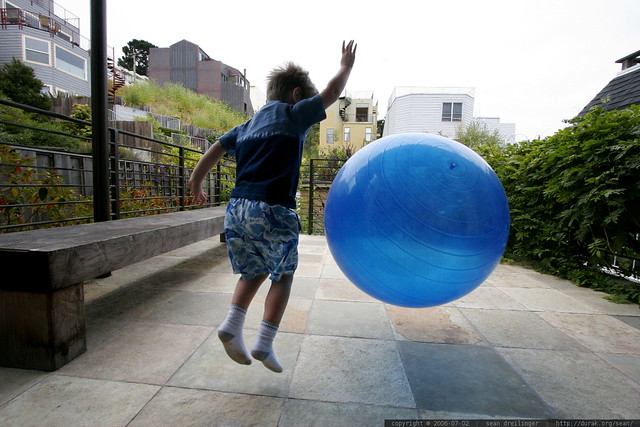-
 6 min. read
6 min. read
-
 WebFX Team
WebFX Team Digital Marketing Agency
Digital Marketing Agency
- The WebFX team is made up of more than 450 subject matter experts in digital marketing, SEO, web design and web development, social media, and more. Together, they’ve helped WebFX’s clients earn more than $3 billion in revenue from the web — and that’s just in the past five years. @webfx
 [photo by sean dreilinger]
[photo by sean dreilinger]
Bounce! Go ahead … it’s okay!
That’s right, I said it – Bounce!
The term “Bounce” or “Bounce Rate” has a negative connotation surrounding it when referring to site analytics. There are many instances when bounces are a typical aspect of traffic however, and it’s (gasp!) not always a bad thing.
Types of Content
Before you even begin looking at your analytics, it’s important to understand what type of visitor you are driving to your site, the anticipated lifecycle of these visitors and your actual goals for these pages.
Blogs – It is common for visitors to blogs to bounce.
Many visitors find a link to a blog post from a blog they frequent; they visit the link, view the blog post and simply close it out. Now if you have a lot of valuable content and internal links in your blog post that refer to related content on the same topic found within your blog; you MIGHT be able to get visitors to travel further into your blog – but otherwise it’s the normal course of action.
Image Sharing, Image Galleries, etc. – If your site is mostly images or heavily relies on traffic from Google Images or people who are searching for images to view then it is likely your visitors will bounce. They will search on Google images or some sort of image search, view the image you have available and then bounce.
They will likely return back to the image results of their original search and then continue to view other images on other sites. Now, if you add related images, similar images or can group images by a topic there is a SLIGHT chance you can get visitors to click on other images and continue through your site; otherwise it is again a normal course of action for this type of visitor.
Flash Sites – If your site is a full flash site, then it is possible the entire site loads on one page. Even if they load and / or look at 10 pages within the flash movie it still only counts as one page view and eventually a bounce.
Setting up advanced analytics pageview tracking will help you get a more accurate understanding of what visitors are doing on flash sites.
Comparison Shopping – If you’re driving traffic into your site for specific products and the terms visitors are using are closer to the buying cycle, visitors may come in to get information, gather pricing and spec data and bounce to compare pricing on other sites that are listed. This is common, but doesn’t necessarily mean that particular visitor didn’t come back and eventually make a purchase; it’s simply part of the process for this type of visitor in this stage of the buying cycle.
Videos – People love videos, and it’s a great way to drive traffic into your site (if you have them properly optimized!). Someone who clicked on the link to your video from search results is highly likely to watch the video, click the back button and then return to their search results to watch more videos.
You may be able to pair the video up with related videos, articles, products and / or solutions that work well with the video and the visitor’s search; but other than that, it is likely this type of visitor will ultimately bounce.
Meeting Your Visitors’ Expectations Before They Bounce
There is the old frame of mind still lingering on the net that says “if I can drive them to my site, I can make them convert”. Unfortunately, this is far from true. In the Ecommerce world, there are terms that are meant to convert and terms that are not meant to convert (initially).
Both understanding the visitor’s expectations and meeting those expectations when the visitor lands on your site are the only ways to ultimately get the sale.
Below I will go into a few advanced steps that should be taken to have a more successful organic and paid search marketing campaign by lowering your site’s bounce rate wherever possible.
Review Your Site – Look at your site and each of its pages on a page-by-page basis and determine what each page offers, its own goals separately and its role within the entire site.
Assign Keywords Based On Expectation– On a keyword-by-keyword basis, determine the possible expectations of a visitor making a search using a specific keyword.
Users’ Intent – Users have actions they wish to carry out when performing a search. You want the page you selected within your site to match up with the actions the users wish to carry out when searching a specific keyword.
Setup Analytics – Once you have determined the three areas above, make use of the goals function in Google Analytics to setup goals and funnels based on your findings. Use the available information to gauge how accurate you were and make the needed adjustments to increase performance.
Review analytics –Review your goals and ensure they include all the possible variations of goals for your site.
Review the keywords that are driving traffic to your site. When looking at how to better an existing campaign and for actionable data, simply work backwards.
Landing Pages – Review your landing pages and what keywords are driving traffic to that landing page. Ask yourself a few questions: does this landing page meet the user’s intention?
Would a better page within the site provide a better user experience? Is there a gap between what my content offers and what my site offers?
Keywords – If visitors are landing on a page that doesn’t match up with what they were expecting to find, work on transferring that traffic to the appropriate page. Search engines aren’t as smart as humans; just because the search engines have determined they have the right page to rank for a certain keyword, doesn’t mean they are right.
Content Strategy – Create a content strategy based on any area within your site that is lacking and how you could better meet your visitors’ expectations.
Remember: obtaining traffic for a competitive term can be difficult and maintaining that position may be even harder; but to drive traffic into a page that doesn’t meet the users’ expectations where they end up bouncing for the wrong reason makes all your hard work and effort futile.
When building pages for your site, make sure you understand the purpose of that page and base its performance based on that goal.
Then brainstorm ideas to help improve and increase that goal.
When looking at your analytics, remember you can’t just look at bounce rates and make good decisions without considering the primary intention of that page, why it was built in the first place and how it is used by your visitors.
-
 The WebFX team is made up of more than 450 subject matter experts in digital marketing, SEO, web design and web development, social media, and more. Together, they’ve helped WebFX’s clients earn more than $3 billion in revenue from the web — and that’s just in the past five years.@webfx
The WebFX team is made up of more than 450 subject matter experts in digital marketing, SEO, web design and web development, social media, and more. Together, they’ve helped WebFX’s clients earn more than $3 billion in revenue from the web — and that’s just in the past five years.@webfx -

WebFX is a full-service marketing agency with 1,100+ client reviews and a 4.9-star rating on Clutch! Find out how our expert team and revenue-accelerating tech can drive results for you! Learn more
Try our free Marketing Calculator
Craft a tailored online marketing strategy! Utilize our free Internet marketing calculator for a custom plan based on your location, reach, timeframe, and budget.
Plan Your Marketing Budget

Looking for More?
Get expert ideas, industry updates, case studies, and more straight to your inbox to help you level up and get ahead.
"*" indicates required fields
Try our free Marketing Calculator
Craft a tailored online marketing strategy! Utilize our free Internet marketing calculator for a custom plan based on your location, reach, timeframe, and budget.
Plan Your Marketing Budget





